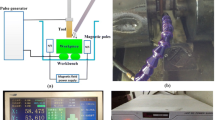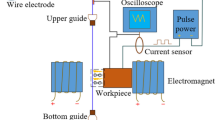Abstract
The magnetized sintered NdFeB (MS-NdFeB) permanent magnet material is difficult to machine due to high hardness, brittleness, and magnetic force. In this paper, the electrical discharge machining (EDM) of the MS-NdFeB workpiece is studied to improve the machining process of the MS-NdFeB. In addition to the material removal rate (MRR) and the surface roughness (SR), the change rate of the magnetic flux density (MCR) for the MS-NdFeB is proposed and used as the research index of their machining effect by the EDM process. By orthogonal experiments, using the intuitive analysis method and the analysis of variance (ANOVA) method, study the influences of the peak current, the pulse on time, the pulse off time, and the magnetic field intensity of the processing area (MF) on the MRR, the SR, and the MCR. The scanning electron microscope (SEM) pictures of the machined MS-NdFeB surfaces are obtained based on the experimental design with a one-factor variation. The comparative experiment is performed to reveal the change of the MCR in EDM. The intuitive analysis of the orthogonal experimental result reveals regularities of influences. The ANOVA reveals the significance of influences. The regularities and significance of influences of machining parameters on the machining effects are analyzed assisted by the analysis on these SEM pictures and the comparative experimental results. The optimal combinations of machining parameters for MRR, SR, and MCR are obtained by single-objective optimization. The verification experiments prove the reliability of the single objective optimization results.













Similar content being viewed by others
Data availability
All data and material generated or used during the study appear in the submitted article. Others are available from the corresponding author by request.
References
Wong YJ, Chang HW, Lee YI, Chang WC, Chiu CH, Mo CC (2020) Coercivity enhancement of thicker sintered NdFeB magnets by grain boundary diffusion with low-melting Tb75−xCexCu25 (x = 0–45) alloys. J Magn Magn Mater 515:167287
Yang Q, Wang R, Liu Y, Li J, Chen H, Yang X (2020) Coercivity enhancement by low oxygen content graphene addition in hotdeformed Nd-Fe-B magnets. J Magn Magn Mater 511:166940
Chen H, Yang X, Sun L, Yu P, Zhang X, Luo L (2019) Effects of Ag on the magnetic and mechanical properties of sintered NdFeB permanent magnets. J Magn Magn Mater 485:49–53
Li J, Huang X, Zeng L, Ouyang B, Yu X, Yang M, Yang B, Rawat RS, Zhong Z (2020) Tuning magnetic properties, thermal stability and microstructure of NdFeB magnets with diffusing Pr-Zn films. J Mater Sci Technol 41:81–87
Takezawa H, Yokote N, Mohri N (2016) Influence of external magnetic field on permanent magnet by EDM. Int J Adv Manuf Technol 87:25–30
Li X, Wei D, Li Q, Yang X (2020) Study on effects of electrode material and dielectric medium on arc plasma in electrical discharge machining. Int J Adv Manuf Technol 107:4403–4413
Ji R, Liu Y, Diao R, Zhang Y, Wang F, Cai B, Xu C (2014) Experimental research on electrical discharge machining characteristics of engineering ceramics with different electrical resistivities. Int J Adv Manuf Technol 75:1743–1750
Li L, Wei XT, Li ZY, Cheng X (2015) Corrosion resistance analysis of sintered NdFeB magnets using ultrasonic-aided EDM method. J Mater Eng Perform 24:536–542
Li L, Cheng X, Sima Z, Niu Z (2015) Machinability of NdFeB magnet via wire and sinking EDM methods. Indian J Eng Mater Sci 22:407–413
Li L, Yang S, Niu Z, Zheng G, Sima Z (2015) Anticorrosion performance of sintered NdFeB magnets by EDM in different dielectric fluids. Anti-Corros Meth Mater 62:172–175
Miller SF, Shih AJ, Qu J (2004) Investigation of the spark cycle on material removal rate in wire electrical discharge machining of advanced materials. Int J Mach Tool Manu 44:391–400
Kruusing A, Leppavuori S, Uusimaki A, Petretis B, Makarova O (1999) Micromachining of magnetic materials. Sensors Actuators 74:45–51
Takezawa H, Ichimura Y, Suzuki T, Muramatsu T, Mohri N (2012) Relationship between thermal influence and magnetic characteristics in electrical discharge machining of magnetic materials. Key Eng Mater 516:575–579
Ichimura Y, Takezawa H, Mohri N (2012) Relationship between magnetic flux density and temperature distributions of permanent magnets by EDM. Key Eng Mater 523-524:322–327
Macedo FTB, Wiessner M, Hollenstein C, Esteves PMB, Wegener K (2017) Fundamental investigation of dry electrical discharge machining (DEDM) by optical emission spectroscopy and its numerical interpretation. Int J Adv Manuf Technol 90:3697–3709
Keskin Y, Halkacı H, Kizil M (2006) An experimental study for determination of the effects of machining parameters on surface roughness in electrical discharge machining (EDM). Int J Adv Manuf Technol 28:1118–1121
Tang L, Du YT (2014) Experimental study on green electrical discharge machining in tap water of Ti–6Al–4V and parameters optimization. Int J Adv Manuf Technol 70:469–475
Dong H, Liu Y, Liu T, Li M, Zhou Y, Li D, Sun Q (2019) Water-in-oil nanoemulsion dielectric for both rough and finishing electrical discharge machining. Int J Adv Manuf Technol 104:1485–1495
Gupta A, Joshi SS (2017) Modelling effect of magnetic field on material removal in dry electrical discharge machining. Plasma Sci Technol 19:025505
Takezawa H, Ichimura Y, Yokote N, Mohri N (2013) Change in surface magnetic flux density in EDM of permanent magnets. Proc CIRP 6:112–116
Code availability
Not applicable.
Funding
This study is funded by the Natural Science Foundation of Shandong Province (grant no. ZR2016EEB14) in China.
Author information
Authors and Affiliations
Contributions
Xue Bai: supervision, conceptualization, validation, formal analysis, investigation, data curation, writing—original draft, writing—review and editing, and funding acquisition. Ting-Yi Yang: formal analysis, resources, writing—original draft, and investigation. Xi-Peng Gong: validation and investigation. Li Li: resources and investigation. Jia-Zhi Cui: validation and investigation.
Corresponding author
Ethics declarations
Conflict of interest
The authors declare no competing interests.
Additional information
Publisher’s note
Springer Nature remains neutral with regard to jurisdictional claims in published maps and institutional affiliations.
Rights and permissions
About this article
Cite this article
Bai, X., Yang, TY., Gong, XP. et al. Researches on the EDM of magnetized sintered NdFeB permanent magnetic material. Int J Adv Manuf Technol 115, 3317–3330 (2021). https://doi.org/10.1007/s00170-021-07394-8
Received:
Accepted:
Published:
Issue Date:
DOI: https://doi.org/10.1007/s00170-021-07394-8




